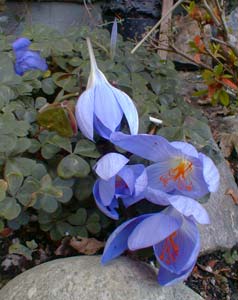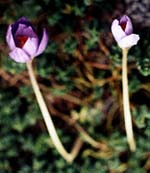 'Conqueror'
'Conqueror'
Autumn Crocus
"We have seen with fiery tongue
Thrice the infant crocus born:
Thrice its trembling curtain hung
In a chink of frozen morn.
This can rear its silken crest:
Nothing thaws her ice-bound breast."
-Lord De Tabley, John Byrne Leicester Warren
(1835-1895)
(1835-1895)
I'd never planted the Autumn Crocus before I planted C. speciosus 'Conqueror' in 2002. The mail-order bulb company's advice about them was imprecise if not intentionally misleading by omissions, because to outline carefully their specific requirements just might discourage a few sales.
Honesty would require admitting how (unlike the best spring crocuses) they have long weak stems -- or a stem-like length of a top-opening tubular flower, with 'Conqueror's' tube-stem even longer than the species. Thereby the flowers reliably flop over on their sides in a terribly disappointing attitude, getting mushed in the first rain or immediately eaten by critters in the soil.
 Granny Artemis & I did not know they really must be planted amidst one or another perfectly suitable companion groundcover, something with dense autumn foliage about ten inches tall to fully brace the flowers. Initially we planted 25 C. speciosus speciousus in an open area without a companion of any sort, & 25 C. speciosus 'Conqueror' bulbs amidst a ground-hugging sedum which alas was not at all tall enough to uphold the unexpectedly tall slim completely tippy blooms.
Granny Artemis & I did not know they really must be planted amidst one or another perfectly suitable companion groundcover, something with dense autumn foliage about ten inches tall to fully brace the flowers. Initially we planted 25 C. speciosus speciousus in an open area without a companion of any sort, & 25 C. speciosus 'Conqueror' bulbs amidst a ground-hugging sedum which alas was not at all tall enough to uphold the unexpectedly tall slim completely tippy blooms. The photo here at the left is from November 2002, & the little photo on the right is a couple weeks earlier in October. As snake-headed buds & as young open flowers they still stood upright, but as soon as they are fully open, or slightly before, they fell right on their sides & nothing can prevent it.
The photo here at the left is from November 2002, & the little photo on the right is a couple weeks earlier in October. As snake-headed buds & as young open flowers they still stood upright, but as soon as they are fully open, or slightly before, they fell right on their sides & nothing can prevent it.These two small photos show this autumn crocus to be somewhat diminuative, but this is only so the first year. In their second year they are the biggest crocuses imaginable, with the tube-stems lifting the big blooms ten inches in the air. In 2002 we also didn't realize their first-year size was a mere hint of their size after getting established. For their ultimate size they are to be highly praised, but their floppiness is just so damned discouraging.
We had planted them very early in autumn 2002 & they bloomed the same autumn they were put in the ground. Both drifts of blossoms fell flat & were near-complete disappointments.
Still, I was not about to give up on them. If I'd ever seen them in another local garden I'd've known better what to do with them, but as it was, I had to work out a century-old puzzle on my own. I found belated advice from A. E. Bowles in My Garden in Autumn & Winter (1915) who notes that certain autumn-blooming species of crocuses, such as do not have leaves until after the blooms are done, are by their flopping habit susceptible to frost damage, which further begs them to be planted amidst a protective groundcover.
These crocuses naturalize easily & return each year, so I was thinking that for future autumns they would look much better with the correct groundcover established over them. To grow over the 'Conqueror' we added dwarf Tricolor Marjoram. This is a delicate evergreen & not fully winter-hardy in our zone, but it lasts nicely through the Autumn. It grows to six inches tall, densely leafed & semi-woody. The marjoram almost did the trick, but not quite. The first year these autumn crocuses were only five or seven inches tall, & the marjoram would've been the perfect companion that year, but the second year, the bulbs produced ten inch long tubes & heavy four inch wide flowers, so they raised high above the marjoram & tipped right over on top of the yellow-green marjoram leaves. Failed a second year, drat.
The second drift of 'Conquerer' that had fallen over in 2002, by 2003 we had established over it the evergreen form of Oregon Oxalis which stops blooming about the same time the crocus buds pop through in September & October. I worried a bit that the oxalis needed more water than the crocus, & less sun, but it seemed worth the experiment. Alas again, because we didn't know that the crocuses would be so very much taller the second year, the four inch tall dense groundcover of oxalis did nothing but prevent the crocus blooms from falling over flat. The first picture above shows some of the second-year blooms which were enormous compared to the first year & very richly colored, but which just laid down on the oxalis leaves ruining their own potential showiness.
They could of course be planted in grass to cure the weak & tippy element, but this too requires cautious planning because the autumn blooms have no leaves whatsoever while in bloom. The grassy leaves arrive later on in winter, & lasts through spring. If the corms are to survive for the next year & begin to naturalize, their spring grass cannot be mowed or pulled up, or the corms will just become depleted. Further, they don't compete well with densely rooted grass, & if grasses were to be their bracing companions, it'd have to be a rather thin meadowy variety, not a thickly rooting lawn turf.
So our 'Conqueror' bulbs were lifted & replanted so close to the front of a tulip garden that they were in thin grass at the edge of the lawn. When the blooms appeared anew in October (2004), they weren't quite as tippy as previously, but still a very long way form satisfactory. That was three tries in three, with marjoram & oxalis & thin turf, & three failures at finding the right companion. My thinking at the moment, before these have their fourth autumn in our gardens, plant over them a taller oregano or thyme, or a semi-evergreen short & spreading rockrose (something like Cistus hybridus), but I'm beyond discouragement by now & am just thinking of it as an ongoing experiment. The other option which I think may turn out to be a first-rate companion would be a semi-evergreen ornamental strawberry.
Our other variety of this species, C. speciosus ssp speciosus, has its own page, & a similar story with regard to other groundcovers tried. But these finally succeeded most impressively when placed amidst semi-wild Grape Hyacinths (Muscari botryoides) which produce lots of autumn grass just before the Autumn Crocuses bloom, & the muscari grass is itself so thick & nice it upholds the leafless crocus flowers exceedingly well. This looks to be the best possible bracing companion, but only where the crocus bulb was seriiusly over-crowded by a great deal of M. botryoides, & the area is so densely populated by naturalized grape hyacinth bulbs that these could make it difficult for the autumn crocus to naturalize in turn. We've other species of muscaris but they don't produce the same early autumn grass, & though there are few other bulbs that do produce autumn grass, they do so too late to brace the crocuses. I am reluctant to extend the already extensive area over which M. botryoides grows merely for the sake of 'Conqueror,' but may eventually lift 'Conqueror' to move amidst the extant muscaries.
We do have other species of autumn crocuses with less extreme floppiness, & these are all upheld by just about any good groundcover tried, so it is only C. speciosus that bamboozled us. But it is also C. speciosus that blooms best & longest, so it's hard to rely exclusively on other species.
Nothing short of the grape hyacinth has as yet proven 100% perfect as bracing companions for C. speciosus, & looking to the best crocus afficianados for pointers has not netted any perfect solutions. Even the brilliant A. E. Bowles, who introduced so many varieties of crocuses to the world, admitted, "I have not yet hit upon what I consider a thoroughly satisfactory pair of stable companions or messmates," though he reported C. speciosus did fairly well with Geranium altanticum as its bracing companion.
Bowles did not find even G. atlanticum perfect, but adequate for the job. Since even Bowles lacked a perfect solution, no wonder my mere self has been having trouble! My crane's-bill collection does not include the species he recommended, but I don't think he meant it had to be G. atlanticum per se. Any crane's-bill should be just as good so long as the species or variety selected was very compact rather than thin or rangily spreading, not apt to get taller than the autumn crocus, with small leaves rather than big ones, & with no signs of die-back in autumn. One that would fit the bill would be evergreen Geranium cantabrigiense. I've not tried a crane's-bill as the bracing companion as yet, but will eventually explore Bowles' recommendation further.
It's unfortunate no grower has cultivated a strong-tubed or short-tubed variety that will stand up. The species is otherwise the most forgiving of all the autumn blooming crocuses, with by far the largest flower. If given a warm sunny slope it will seed easily, plus the parent corms will develop a ring of cormlets, becoming a finer drift of flowers with each new autumn.